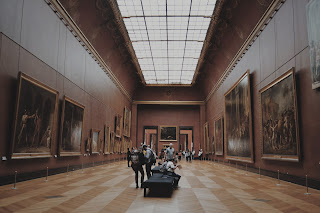Paul Graham on Good Taste
Tuesday, January 18, 2022
Although Paul Graham doesn't get around to saying exactly what good taste is or might be, his most recent essay is a good argument for its existence, not to mention food for thought on many related issues.
Highly relevant to all of this is why he felt the need to argue the point:
One such conclusion is that "If there's no such thing as good taste, then there's no such thing as good art."When I was a kid, I'd have said there wasn't. My father told me so. Some people like some things, and other people like other things, and who's to say who's right?
Image by Amy-Leigh Barnard, via Unsplash, license.
It seemed so obvious that there was no such thing as good taste that it was only through indirect evidence that I realized my father was wrong. And that's what I'm going to give you here: a proof by reductio ad absurdum. If we start from the premise that there's no such thing as good taste, we end up with conclusions that are obviously false, and therefore the premise must be wrong.
This is a profound point, and points to an important implicit premise: There must be good, bad, and objective ways to distinguish between the two. (I think Graham agree on good and bad, but is unsure on the matter of objectivity.)
This Graham assumes, and it is fun and instructive to see where he goes with art -- an area for which there is no shortage of people who will claim that it is a subjective, anything goes type of endeavor.
And that is on top of the fact that people can have other bases for disagreement about judging art, just like they can for anything else. Oh, and Graham very interestingly hits on an issue I wouldn't have thought of on my own -- the idea that the goodness of art might be inherent to the object:
The other reason people doubt that art can be good is that there doesn't seem to be any room in the art for this goodness. The argument goes like this. Imagine several people looking at a work of art and judging how good it is. If being good art really is a property of objects, it should be in the object somehow. But it doesn't seem to be; it seems to be something happening in the heads of each of the observers. And if they disagree, how do you choose between them? [bold added]I don't agree with his answer to this problem, but I enjoyed reading it:
The solution to this puzzle is to realize that the purpose of art is to work on its human audience, and humans have a lot in common. And to the extent the things an object acts upon respond in the same way, that's arguably what it means for the object to have the corresponding property. If everything a particle interacts with behaves as if the particle had a mass of m, then it has a mass of m. So the distinction between "objective" and "subjective" is not binary, but a matter of degree, depending on how much the subjects have in common. Particles interacting with one another are at one pole, but people interacting with art are not all the way at the other; their reactions aren't random -- far from it. [bold added]Graham follows this with other thoughts that, while I didn't agree with all of them, I found them worthwhile.
It is at this point that I think it is worthwhile to recall Ayn Rand's definition of art, since it touches on the fact that art is intended for a human audience:
Art is a selective re-creation of reality according to an artist's metaphysical value-judgments. Man's profound need of art lies in the fact that his cognitive faculty is conceptual, i.e., that he acquires knowledge by means of abstractions, and needs the power to bring his widest metaphysical abstractions into his immediate, perceptual awareness. Art fulfills this need: by means of a selective re-creation, it concretizes man's fundamental view of himself and of existence. It tells man, in effect, which aspects of his experience are to be regarded as essential, significant, important. In this sense, art teaches man how to use his consciousness. It conditions or stylizes man's consciousness by conveying to him a certain way of looking at existence.Even with this, there is much we have yet to learn from many disciplines before we'd be able to develop anything close to a comprehensive understanding of how to judge whether art is good, but that doesn't mean there aren't objective criteria for good art or that it is impossible to judge the merit of a work of art. (See Rand, especially regarding what it would take to have objective criteria for judging music.)
That makes it a little harder to say what good taste is, but my stab at it would be this: Good taste describes a highly intuitive or near-instantaneous ability -- perhaps derived through long or thorough study of a field -- to accurately judge something as good or bad.
I think taste can be corrected or improved through study or, for an intellectually active mind, by immersion in a field. However, it is an interesting question as to how much, because I would suspect that there has to be integration between one's conscious premises and aspects of one's subconscious mind, i.e. one's emotional responses and one's memories. The first is within one's control and the other likely isn't, or at least isn't completely.
-- CAV


No comments:
Post a Comment